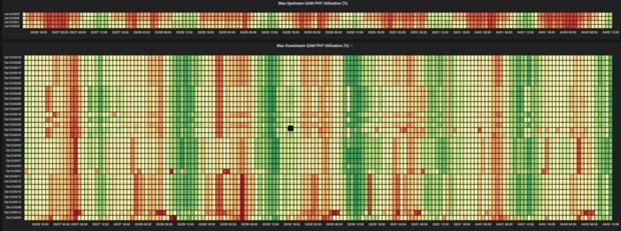The current global health crisis has accelerated usage of broadband access networks almost overnight. High quality broadband access has taken center stage as hundreds of millions of people have replaced face-to-face activities with virtual ones. According to NCTA, upstream usage increased by 34.9% and downstream by 18.7% from early March to early May.
Many of these new usage behaviors are predicted to persist well beyond the day when the current health situation has subsided, and some market leaders are already taking action to accommodate this growth. So how do you handle the shifts in demand today, and be ready for tomorrow’s next steps?
New tools for monitoring upstream network health
At Harmonic, we are already working with our operator partners to assess the impact of the new traffic patterns. We see upstream traffic peaking at higher levels, and those peaks persisting for most of the day.

cOS™ Central Dashboard for Upstream Monitoring
Cable plant upstream capacity is still generally very constrained, since few operators have transitioned to 1.2 GHz downstream spectrum and most still only allocate a small slice of spectrum to upstream.
Today, it’s common to see upstream frequency splits at around 42 MHz in North America, and up to 65 MHz in Europe. With the lower frequencies (below 15-20 MHz) generally considered unusable due to noise, this leaves only 20-40 MHz of spectrum available for upstream data and voice services – typically allowing at best 50-200 Mbps of shared data capacity — a serious bottleneck when handling an explosion of two-way video conferencing and other traffic growth.
Harmonic works with our cable customers to provide unprecedented visibility into the health of their cable network. With cOS Central, which leverages advanced telemetry made possible by cOS platform's unique virtualized software foundation, you have access to easy-to-use graphs and displays showing instantaneous and historical charts and statistics. These data-rich analytics help you identify network related noise issues and determine when and where to take action. Harmonic has also developed heatmaps showing channel utilization so you can easily identify congestion and resolve issues before they occur to protect the customer experience.

Heat Map to Manage Congestion
Short-term optimization for your upstream configuration
Once upstream capacity issues are identified, the following tactics may be applied to provide short-term congestion relief.
- DOCSIS services allow many ways to assign priority on the upstream. Consider taking advantage of this by defining new classifiers to identify additional specific traffic types for prioritization. For example, prioritize work at home applications like Zoom, over file transfers.
- Consider better optimizing modulation profiles for your upstream channels to ensure that the highest order modulation schemes can be used for DOCSIS 3.0 and DOCSIS 3.1, in the event that your hybrid fiber coaxial (HFC) network allows for it. Even if it can be utilized only for short periods, it will provide a capacity boost.
- Consider utilizing some of the upstream spectrum below 20 MHz for channels that can be handled with lower order modulation schemes.
- Consider deploying DOCSIS 3.1 channels if your spectrum allows for it. DOCSIS 3.1 allows much higher order modulation schemes to provide more capacity per MHz of Spectrum along with advancements in Forward Error Correction to make signals more robust, protecting capacity.

The path to long-term network flexibility
Turning to longer-term solutions, cable operators have more options to increase upstream capacity. One option is to move to a 204 MHz upstream split. It’s available in DOCSIS 3.1 and supported by most cable access technology companies. However, this kind of split requires expensive and time-consuming changes to the actives and passives in the outside plant.
Cable operators, along with CableLabs, are currently developing more options to increase upstream capacity, working in particular on moving to symmetric capacity. For now, these efforts are part of the DOCSIS 4.0 specifications that are currently being finalized at CableLabs. Although still several years away, DOCSIS 4.0 is expected to offer two alternatives for significantly increasing upstream capacity: Extended Spectrum DOCSIS (ESD), which involves extending the Downstream spectrum to 1.8 GHz or beyond, and Full Duplex DOCSIS (FDX), allowing a move towards more symmetrical services approaching 10Gbps which typically requires ‘Node+0’ (meaning no actives downstream from the node). There will be a number of network design variations possible when utilizing these two options.
The critical importance of operational agility and efficiency
Rapidly increasing broadband consumption requires unprecedented speed and agility to adapt and continue to deliver the services that have become the critical link for our connected lifestyles and working arrangements. This is where a software-based, cloud-native solution, complemented by state-of-the-art monitoring and management capabilities that provide detailed data and analytics, becomes essential. Access networks need solutions that can provide the necessary flexibility to evolve, and the data-driven intelligence to adapt, without the historically compounding costs of traditional hardware-based solutions.
Harmonic’s cOS broadband platform gives you the data and agility you need to enhance your network and deliver the future of broadband today. With the improved signal quality, enabled by Remote-PHY technology, and the cost-effective scalability of Virtualized CCAP technology, you can quickly and easily expand broadband capacity and ensure the best experience for your subscribers at every location you serve.
Let us know if you have questions about expanding your broadband capacity and we’ll be glad to get in touch.










